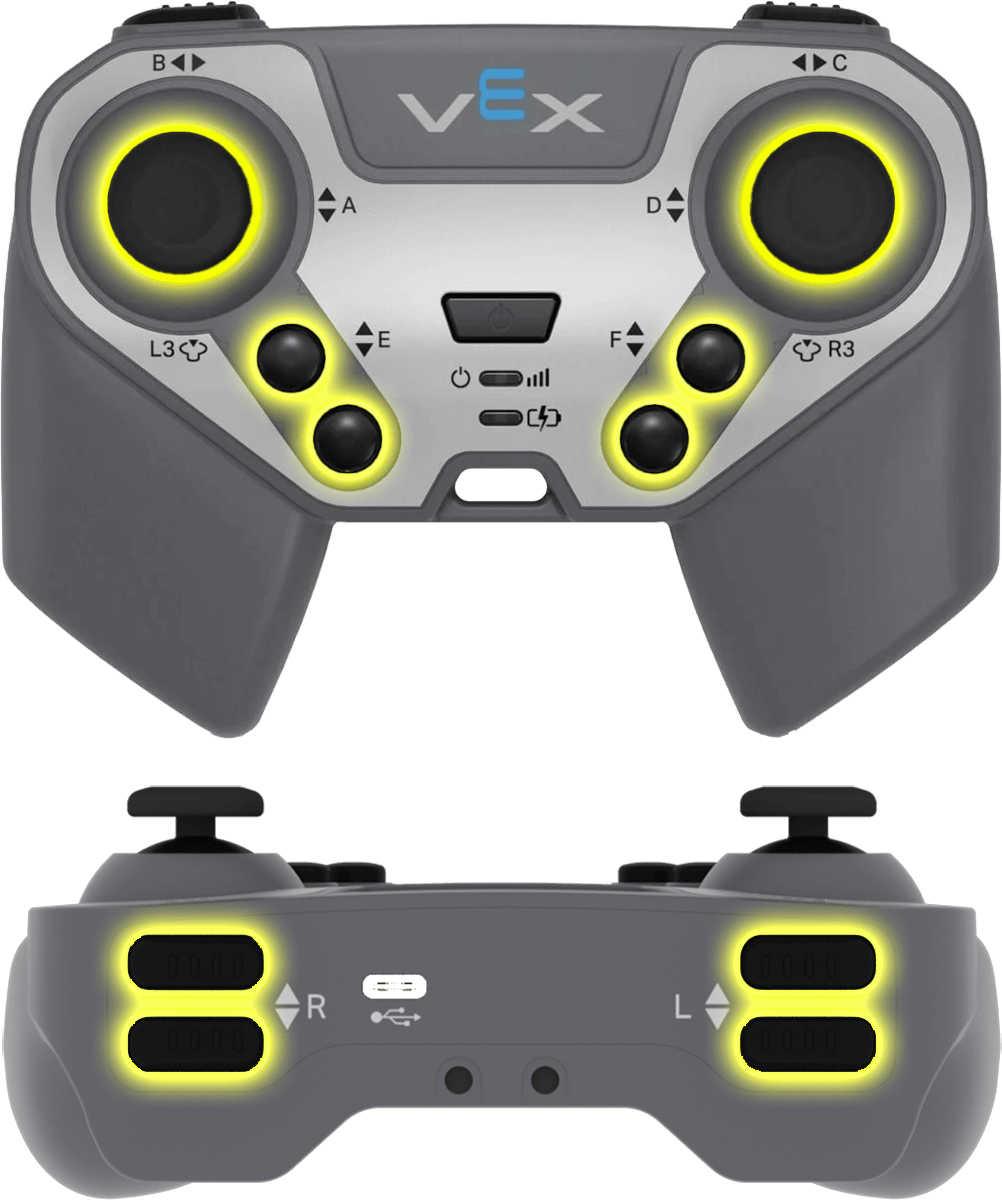Controller#
Introduction#
The IQ (2nd gen) Brain can connect to either an IQ (2nd gen) or IQ (1st gen) Controller. Both controllers have two analog joysticks and multiple buttons that the Brain can use to detect movements and presses.
For the examples below, the configured Distance Sensors will be named Controller, and will be used in all subsequent examples throughout this API documentation when referring to Controller class methods.
Below is a list of available methods:
Actions - Enable or disable the controller.
RemoteControlCodeEnabled– Enables or disables controller configured actions.
Getters - Return values from controller joysticks and buttons.
pressing– Returns whether the specified button is being pressed.position– Returns the position of the joystick’s specified axis.
Callback – Interact with the controller through callback methods.
pressed– Calls a function when the specified button is pressed.released– Calls a function when the specified button is released.changed– Calls a function when the joystick’s axis changes.
Constructors – Manually initialize the Controller.
controller– Create a Controller.
Actions#
RemoteControlCodeEnabled#
RemoteControlCodeEnabled is a variable that can be set to a Boolean that enables or disables Controller configured actions from the Devices menu. The controller is enabled by default. It can be set to either of the following:
true— Enable Controller configured actions.false— Disable Controller configured actions.
Usage:
RemoteControlCodeEnabled = false;
int main() {
// Initializing Robot Configuration. DO NOT REMOVE!
vexcodeInit();
// Drive forward or backward using the left joystick
RemoteControlCodeEnabled = false;
while (true) {
if (Controller.AxisA.position() > 0) {
Drivetrain.drive(forward);
} else if (Controller.AxisA.position() < 0) {
Drivetrain.drive(reverse);
// Press E ▲ to use the controller configured actions
} else if (Controller.ButtonEUp.pressing()) {
break;
} else {
Drivetrain.stop();
}
wait(20, msec);
}
RemoteControlCodeEnabled = true;
}
Getters#
pressing#
pressing returns an integer indicating whether a specific button on the controller is currently being pressed. This method must be called on a specific button object, such as ButtonEDown (see full list of button objects below).
1- The specified button is being pressed.0- The specified button is not being pressed.
Usage:
One of ten available button objects can be used with this method, as shown below:

Button |
Command |
|---|---|
|
|
|
|
|
|
|
|
|
|
|
|
|
|
|
|
|
|
|
|
Parameters |
Description |
|---|---|
This method has no parameters. |
int main() {
// Initializing Robot Configuration. DO NOT REMOVE!
vexcodeInit();
// Turn right while E Up is held
while (true) {
if (Controller.ButtonEUp.pressing()) {
Drivetrain.turn(right);
} else {
Drivetrain.stop();
}
wait(20, msec);
}
}
position#
position returns the position of the joystick’s specified axis as an integer from –100 to 100, representing a percentage. This method must be called on a specific axis object, such as AxisA (see full list of axis objects below).
Usage:
One of four available axes can be used with this method, as shown below:

Axis |
Command |
|---|---|
|
|
|
|
|
|
|
|
Parameters |
Description |
|---|---|
This method has no parameters. |
int main() {
// Initializing Robot Configuration. DO NOT REMOVE!
vexcodeInit();
// Turn with the left joystick
RemoteControlCodeEnabled = false;
while (true) {
if (Controller.AxisB.position() > 10) {
Drivetrain.turn(right);
} else if (Controller.AxisB.position() < -10) {
Drivetrain.turn(left);
} else {
Drivetrain.stop();
}
wait(20, msec);
}
}
Callback#
pressed#
pressed registers a function to be called when a specific button on the controller is pressed. This method must be called on a specific button object, such as ButtonEDown – (see full list of button objects below).
Usage:
One of ten available button objects can be used with this method, as shown below:

Button |
Command |
|---|---|
|
|
|
|
|
|
|
|
|
|
|
|
|
|
|
|
|
|
|
|
Parameter |
Description |
|---|---|
|
The callback function to be called when the specified button is pressed. |
// Drive forward when E Up is pressed
void driveForward() {
Drivetrain.driveFor(forward, 100, mm);
}
int main() {
// Initializing Robot Configuration. DO NOT REMOVE!
vexcodeInit();
Controller.ButtonEUp.pressed(driveForward);
}
released#
released registers a function to be called when a specific button on the controller is released. This method must be called on a specific button object, such as ButtonEDown – (see full list of button objects below).
Usage:
One of ten available button objects can be used with this method, as shown below:

Button |
Command |
|---|---|
|
|
|
|
|
|
|
|
|
|
|
|
|
|
|
|
|
|
|
|
Parameter |
Description |
|---|---|
|
The callback function to be called when the specified button is released. |
// Drive backward when F Down is released
void backUp() {
Drivetrain.driveFor(reverse, 100, mm);
}
int main() {
// Initializing Robot Configuration. DO NOT REMOVE!
vexcodeInit();
Controller.ButtonFDown.released(backUp);
}
changed#
changed registers a function to be called when the joystick’s position changes. This method must be called on a specific axis object, such as AxisA (see full list of axis objects below).
Usage:
One of four available axes can be used with this method, as shown below:

Axis |
Command |
|---|---|
|
|
|
|
|
|
|
|
Parameters |
Description |
|---|---|
|
The callback function to be called when the specified axis’s position changes. |
// Play a sound when the right joystick moves
void beep() {
Brain.playSound(tada);
wait(1, seconds);
}
int main() {
// Initializing Robot Configuration. DO NOT REMOVE!
vexcodeInit();
Controller.AxisD.changed(beep);
}
Constructors#
controller#
controller creates a controller object.
Usage:
controller Controller = controller();
Parameter |
Description |
|---|---|
This method has no parameters. |
int main() {
// Initializing Robot Configuration. DO NOT REMOVE!
vexcodeInit();
// Create a Controller object
controller Controller = controller();
// Drive forward while R Up is held
while (true) {
if (Controller.ButtonRUp.pressing()) {
Drivetrain.drive(forward);
} else {
Drivetrain.stop();
}
wait(20, msec);
}
}
